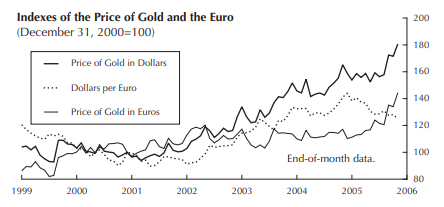Gold bullion closed in London at $502.50 per ounce on December 2. The P.M. fix had not been above $500 since 1987. Even though, as shown in the chart below, the dollar price of gold had been steadily increasing for five years or so, it was the $500 “milestone” that put gold back in the headlines of the financial press. Many attributed the strengthening of the gold price to the weakening dollar. Indeed, the trend of the dollar price of gold and the price of euros in dollars closely paralleled each other during 2002, 2003, and 2004. The price of gold in euros was essentially flat during those years. Its monthly average did not exceed its level in the spring of 2002 until last June. The dollar price increased more than one third during the same period.
If the increasing price of gold was merely a reflection of the foreign exchange value of the dollar, then a strengthening of the dollar could have been expected to be accompanied by a decrease in the dollar price of gold. But this is not what happened. Since the end of last year, the dollar price of gold has increased by nearly 14 percent, while the dollar price of euros has decreased by roughly the same amount (note how the two curves have diverged during recent months).

That the price of gold has increased in dollars and euros (as well as other major currencies) has been seen by many observers as an indication that investors have been providing against an acceleration of the loss of purchasing power of paper money, i.e., that they have come to expect higher rates ofgeneral price inflation here and abroad. However, much of the recent sharp run-up in the gold price has apparently reflected speculative buying on the basis of its “price momentum.”
Those who are buying gold simply because its price has been going up will probably tire of it if the price levels off (even temporarily). Nevertheless, it appears likely that overall demand will remain strong as the increasing prosperity of China and India (as well as the current high oil price) means increased demand among groups in Asia and the Middle East with long-standing traditions of holding gold as a store of value.
As for supply, it will be several years before mining projects that were “mothballed” when the price of gold was low can be brought on stream. However, if the price of gold continues to increase markedly, it can be expected that the world’s central banks, which still hold approximately half of all gold that is in “good delivery” form, will at some point become tempted to become sellers. In other words, we have no way of determining how long the “bull market” in gold will last, and neither does anyone else.
As we have often stated, the reason to own gold is not to make money, but to have money in any and all circumstances.
Also in This Issue:
Section 529 Plans: Clearing Up the Confusion
Inflation-Adjusted U.S. Savings Bonds
Placer Dome Offer
Dow Stalwarts?
The High-Yield Dow Investment Strategy
Recent Market Statistics
The Dow-Jones Industrials Ranked by Yield
To access the full article, please login or subscribe below.
Already a Subscriber?
Log in now
Subscribe Today
Get full access to the Investment Guide Monthly.
Print + Digital Subscription – $59/YearIncludes 12 Print and Digital Issues
Print + Digital Subscription – $108/2 Years
Includes 24 Print and Digital Issues
Digital Subscription – $49/Year
Includes 12 Issues
Digital Subscription – $98/2 Years
Includes 24 Issues

